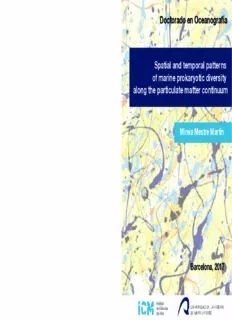Table Of Contente 7
r 1
st 0 Doctorado en Oceanografía
e 2
M
a
i
e
r
i
M
Spatial and temporal patterns
of marine prokaryotic diversity
y
it along the particulate matter continuum
s
r
e
v
i
d
c
i
t
o
y
r Mireia Mestre Martín
a
k
o
r
p
e
m
n
ri u
a u
m n
i
t
f n
o
o
s c
n
r
r e
e
t
t t
t a
a
m
p
l e
a
t
r a
o
l
p u
m c
i
e t
r
t a
d p
n
e
a
h Barcelona, 2017
l t
a
g
i
t n
a
p o
S al
UNIVERSIDAD DE LAS PALMAS DE GRAN CANARIA
Facultad de Ciencias del Mar ANEXO I
Dª MARÍA ISABEL PADILLA LEÓN, SECRETARIA DE LA FACULTAD
DE CIENCIAS DEL MAR, ÓRGANO RESPONSABLE DEL
PROGRAMA DE DOCTORADO EN OCEANOGRAFÍA, DE LA
UNIVERSIDAD DE LAS PALMAS DE GRAN CANARIA.
CERTIFICA
Que el Consejo de Doctores del Programa de Doctorado en
Oceanografía, en su sesión de fecha 25 de mayo de 2017, tomó el
acuerdo de dar el consentimiento para su tramitación, a la tesis doctoral
titulada: “Spatial and temporal patterns of marine prokaryotic diversity along
the particulate matter continuum”, presentada por la doctoranda: Dª Mireia
Mestre Martín y dirigida por los Doctores: D. Josep M. Gasol i Piqué y
Dª M. Montserrat Sala.
Asimismo, se acordó el informar favorablemente la solicitud para
optar a la Mención Internacional del Título de Doctora, por cumplir los
requisitos reglamentarios.
Y para que así conste, a efectos de lo previsto en el Artº 6 del
Reglamento para la elaboración, tribunal defensa y evaluación de tesis
doctorales de la Universidad de Las Palmas de Gran Canaria, firmo el
presente en Las Palmas de Gran Canaria, a veinticinco de mayo de dos
mil diecisiete.
PÁGINA 1 / 1 ID. DOCUMENTO TkzrZnXBDItJmglkpmkRng$$
FIRMADO POR FECHA FIRMA ID. FIRMA
43646105V ISABEL PADILLA LEÓN 24/05/2017 MTIyMzI3
13:49:34
Documento firmado digitalmente. Para verificar la validez de la firma copie el ID del documento y acceda a / Digitally
signed document. To verify the validity of the signature copy the document ID and access to
https://sede.ulpgc.es/VerificadorFirmas/ulpgc/VerificacionAction.action
Anexo II
UNIVERSIDAD DE LAS PALMAS DE GRAN CANARIA
Departamento/Instituto/Facultad______________________________________
Programa de doctorado____________________________________________
Título de la Tesis
Tesis Doctoral presentada por D/Dª___________________________________
Dirigida por el Dr/a. D/Dª. __________________________________________
Codirigida por el Dr/a. D/Dª. ________________________________________
El/la Director/a, El/la Codirector/a El/la Doctorando/a,
(firma) (firma) (firma)
Las Palmas de Gran Canaria, a _____ de_________________ de 20__
A tothom
Contents
SUMMARY / RESUM / RESUMEN 15
GENERAL INTRODUCTION 21
AIMS OF THE THESIS 43
CHAPTER1. Patterns of bacterial diversity in the marine planktonic
particulate matter continuum 49
CHAPTER 2. Seasonality and dynamics of bacterial community structure
along the pelagic particulate matter continuum in a temperate oligotrophic
coastal site 85
CHAPTER 3. Spatial variability of marine bacterial and archaeal
communities along the particulate matter continuum 123
CHAPTER 4. Vertical connectivity in the ocean microbiome:
Sinking particles as dispersal vectors 157
GENERAL DISCUSSION AND FUTURE PERSPECTIVES 195
GENERAL CONCLUSIONS 221
SUMMARY IN SPANISH / RESUMEN EN CASTELLANO 225
ACKNOWLEDGEMENTS 235
Contents
(extended version)
Page
SUMMARY .................................................................................................................. 15
Resum ...................................................................................................................................... 16
Resumen ..................................................................................................................................1 7
GENERAL INTRODUCTION ................................................................................... 21
1 Why studing diversity? .......................................................................................................2 1
2 Measuring diversity ............................................................................................................2 2
3 Diversity of prokaryotes in the ocean ................................................................................ 23
4 Particles in the ocean ..........................................................................................................2 4
5 Prokaryotic lifestyles: free-living and attached ................................................................ 24
6 How separation of gree-living and attached prokaryotes is commonly done? .............. 26
7 Sampling proposal .............................................................................................................3 0
8 References ...........................................................................................................................3 2
AIMS OF THE THESIS .............................................................................................. 43
CHAPTER 1. Patterns of bacterial diversity in the marine planktonic particulate
matter continuum ......................................................................................................... 49
1.1 INTRODUCTION ............................................................................................................5 0
1.2 MATERIALS AND METHODS .................................................................................... 52
1.2.1 Study area, sampling and basic parameters
1.2.2 DNA extraction, sequencing and sequences processing
1.2.3 Data analysis
1.3 RESULTS .........................................................................................................................5 5
1.4 DISCUSSION ...................................................................................................................6 2
1.5 Acknowledgements ..........................................................................................................6 8
1.6 References .........................................................................................................................6 9
1.7 Supplementary Material.................................................................................................. 75
1.7.1 Supplementary Methods
1.7.2 Supplementary Figures
1.7.3 Supplementary Tables
Description:Spatial and temporal patterns of marine prokaryotic diversity along the along the pelagic particulate matter continuum in a temperate oligotrophic.

